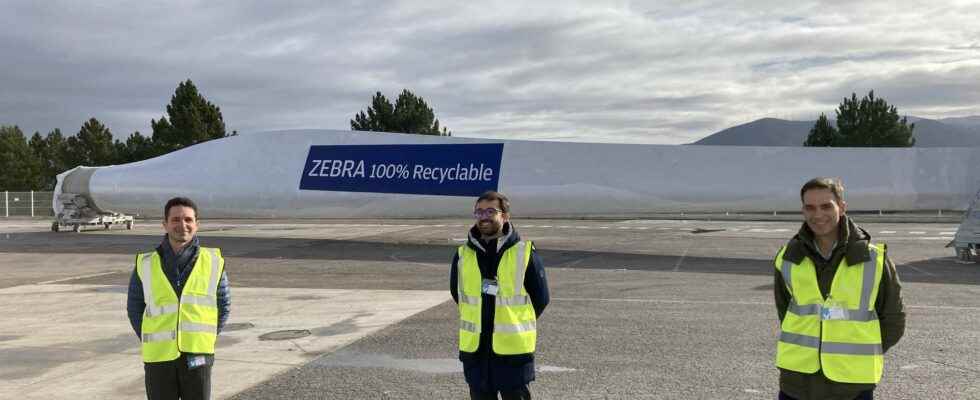You will also be interested
[EN VIDÉO] The incredible construction of a wind turbine in time-lapse Wind power is one of the renewable energies, so it’s a safe bet that the park will grow over the next few years. The assembly of a wind turbine is long and underlines how these structures are a technological jewel, as we can see during this video.
If the renewable energies are essential to the energetic transitionthey must be part of a global eco-design approach to promotecircular economy and the recyclingas is the case with Zebra explained to us by Vianney de Lavernée, head of CSR at Engie Renewables.
What is your CSR approach to renewable energies?
Vianney de Lavernée: Renewable energies are associated with a CSR approach, because we want them to integrate more and more into their natural and human environment. They are indeed one of the levers for responding to the challenges of the energy transition, whether at the social level, of people and the territories they inhabit, but also at the natural level, in particular through the preservation of resources and biodiversity. We must optimize the positive impacts and thus create a regenerative model. Not only do renewable energies reduce emissions of CO2 to reach the carbon neutralitylike Engie’s “net zero” ambition in 2045, but they can be part of a circular economy logic if we promote the eco-design of their components.
Why associate CSR and innovation?
Vianney de Lavernée: Our CSR policy allows us to identify the key elements of our long-term strategy and innovation is the means to implement it. Renewable energies have reached their maturity, hydraulics for a few decades, but now also wind and solar. Innovation therefore allows us to go even further in their development but also to better integrate them into their ecosystems : by putting, for example, solar energy at the service ofagricultureor by using wind power as a lever to better understand the wildlife around the settlement area.
How do you approach innovation in your structure?
Vianney de Lavernée: Innovation essentially starts from the field to unblock situations. To do this, we rely on the good ideas of renewable energy experts and adopt a methodology of ” test and learn to make them happen. Of course, we have also developed a partnership network with start-ups working on our themes. Regarding “intrapreneurship”, we are incredibly lucky within the Group to have a large pool of projects led by motivated and involved employees. This allows us to find solutions fairly quickly when we are faced with an obstacle in our development strategy. For example for the detection of harrier nests by drone upstream of the development of a wind farm.
Do you also benefit from prospective but applied innovations, as is the case with Zebra?
Vianney de Lavernée: Zebra was born from a strategic reflection on the question of the end of life of wind turbines. Beyond the obligation we have to restore the site on which they were installed, there remained the question of recycling the nacelle and the blades. It was the Achilles heel of wind power. From 90% recyclability, we wanted to get as close as possible to 100% in wind power. To do this, we have brought together representatives from the entire value chain around an eco-design approach. The objective: to facilitate end-of-life recycling, reduce energy consumption and waste in the blade manufacturing and recycling phase.
What answer do you bring with Zebra?
Vianney de Lavernée: The Zebra project (for Zero wastE Blade ReseArch) develops a 62 meter blade made from a resin thermoplastic, known for its recyclable but also malleable properties at low temperatures, and new high performance fiberglass materials. At the end of their life, these two components are easily separated. An advanced method of chemical recycling makes it possible to separate the fiber from the resin and to recover a new virgin resin, where before we only made half of the way since the resin was burned. Launched in 2020, the Zebra project brings together a unique consortium, led by the IRT Jules Vernewhich brings together major industry players and technical centers including Arkema, Canoe, Engie, LM Wind Power, Owens Corning and Suez.
Where are you in its implementation?
Vianney de Lavernée: After a year of development, material testing and sub-component level process testing, LM Wind Power has designed and manufactured the world’s largest thermoplastic blade at its factory in Ponferrada, Spain. The trials of duration structural life scale 1 will start in the coming weeks and the validation of recycling methods is planned by the end of December 2022. These advances on the issue of end of life have also been integrated into a label that we , Engie, are in the process of setting up for renewable energies: TED, for Sustainable Energy Transition. It includes nine commitments, reflecting our method for the virtuous development and operation of wind and solar energy, first in France, tomorrow internationally.
Interested in what you just read?
